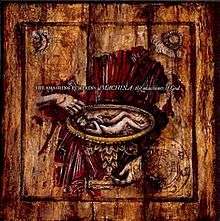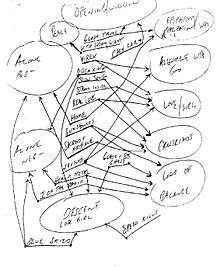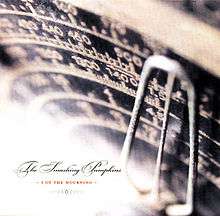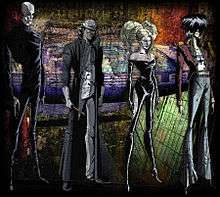Machina/The Machines of God
| Machina/The Machines of God | ||||
|---|---|---|---|---|
 | ||||
| Studio album by The Smashing Pumpkins | ||||
| Released | February 29, 2000 | |||
| Recorded | November 1998 – October 1999 | |||
| Studio | Sadlands, Pumpkinland & Chicago Recording Company, Chicago, Illinois, United States | |||
| Genre | ||||
| Length | 73:23 | |||
| Label | Virgin | |||
| Producer | ||||
| The Smashing Pumpkins chronology | ||||
| ||||
| Singles from Machina/The Machines of God | ||||
|
||||
Machina/The Machines of God is the fifth studio album by the American alternative rock band The Smashing Pumpkins, released on February 29, 2000, by Virgin Records. A concept album,[4] it marked the return of drummer Jimmy Chamberlin and was intended to be the band's final official LP release prior to their first break up in 2000. A sequel album — Machina II/The Friends & Enemies of Modern Music — was later released independently via the Internet.
As with its predecessor, Adore, Machina represented a drastic image and sound change for the band that failed to reconnect the band with chart-topping success. However, after the relatively brief Adore tour, the new line-up with Chamberlin and the former Hole bass guitarist Melissa Auf der Maur mounted longer international tours that returned the live incarnation of the band to a guitar-driven hard rock style.[5]
A remastered and expanded version of the album was announced as a part of the band's project to reissue their back catalogue from 1991 to 2000, though Corgan announced in July 2015 that the release was tied up in legal issues with their record label.
Background and concept
After the Adore tour ended in the second half of 1998, lead singer/guitarist Billy Corgan immediately began to work on new material, playing new songs as early as October of that year.[6] In the same month, the four original band members convened, and decided that Jimmy Chamberlin would rejoin the band, and that a final album and tour would be mounted before the group disbanded permanently.[7] "If you want to know what Jimmy brings back to the band," Corgan told Q, "then listen to Adore and this new record back-to-back. It speaks for itself."[8]
Corgan envisioned a lengthy concept album in conjunction with a musical theater approach to a tour, based around the idea of the band playing exaggerated versions of themselves, as the press and public seemed to view them.[9][10] He later explained, "the band had become such cartoon characters at that point in the way we were portrayed in the media, the idea was that we would sort of go out and pretend we were the cartoon characters."[9]

From there, a story was conceived revolving around a rock star named Zero (based on the public persona of Corgan) hearing the voice of God, renaming himself Glass, and renaming his band The Machines of God. Fans of the band were referred to as the "Ghost Children".
Corgan started recording demos in late 1998 and the band entered the studio in early 1999.
Recording
Much like previous albums, the songs were first tracked acoustically at Corgan's house in late 1998[11] before the band set to work on them at their practice space and the Chicago Recording Company. The recording was conducted with the team responsible for finishing Adore – co-producer Flood and engineers Howard Willing and Bjorn Thorsrud.
The band took a break from recording in April 1999 to embark on the Arising! tour, which took the band to nine small clubs. After the tour's conclusion, the bass guiatrist, D'arcy Wretzky, left the band, leaving the rest of them in a difficult position. Corgan later said, "This put a stress obviously on the full integrity of the project, because it was connected to the band not only bringing the music to fruition fully, but also the public component of being in character. I ended up in a broken band with a half-ass enthusiasm towards finishing a project already started."[12]
Flood later remembered, "We decided that we were going to have to make a very different kind of record [...] we pretty much went back to the drawing board. Certain songs on the record are survivors from that first period, but it meant a shift in the ways songs had to be formed."[13]
Corgan described the new recording process for Machina, now focused more on the song development than on the concept:
| “ | We spent most of the time trying to take the songs as far as they could be taken down a particular avenue. So if it was gonna be proto-cyber metal, we tried to make it very proto and very cyber. If it was acoustic, then we tried to not fall into the typical ballad-y kind of aspects. That's where we spent most of our time. The songs were probably written in about a day.[14] | ” |
In the end, the theatrical qualities of the live performances and appearances were mostly abandoned. Many of the songs on the album refer to the ending of love and relationships (both romantic and otherwise), most of them obvious references to the band themselves. Corgan described "This Time" as "my love song to the band".[15] According to Corgan, the album was structured so that the first eight tracks would be "more poppy", and the last five "more arty".[16] Generally, Corgan appraised the sound of the album as "a rock 'n' roll approach with pop sensibility".[17] After the electronica-influenced Adore, Machina was a return to the distorted guitar sound of previous albums, though synthesizers and acoustic guitars were still heavily used.
Marketing and release
 |
"The Everlasting Gaze"
Sample of "The Everlasting Gaze" from Machina/The Machines of God (2000), the first single from the album. A return to the dense, guitar-heavy sound of previous records. |
| Problems playing this file? See media help. | |
Corgan presented Machina to Virgin Records as a double album, but the label was not interested after the disappointing sales of Adore.[18] Machina was released as a single album on February 29, 2000, with a bonus disc, Still Becoming Apart, available at certain stores.

A video was made for "Stand Inside Your Love", the planned first single, in late 1999, but at the last minute, "The Everlasting Gaze" was issued as the album's first promotional radio single in December 1999. "Stand Inside Your Love" was released as the first commercially available single on January 21, 2000. "I of the Mourning" was also released as a promotional single and received limited airplay. "Heavy Metal Machine" was issued as a promotional cassette but was not distributed to radio stations.[19]
On March 9, the band went on the Thursday edition of @MTV Week at Broadway Studios in New York City for a half-hour live TV special. During the broadcast they performed "The Everlasting Gaze" as well as "I of the Mourning" after an online and call-in voting competition between three songs from Machina. The special also featured Carson Daly interviewing the band members and online chats with the band, and an interactive online video for "The Crying Tree of Mercury".
On May 23, Corgan announced on KROQ-FM that the band would be breaking up at the end of the year.[4] The band reconvened in a studio to finish off the leftover Machina tracks, but Virgin remained uninterested, so the band released Machina II on their own in September, handing them off to fans to distribute free over the Internet.[20]
The video for the final single, "Try, Try, Try", directed by Jonas Åkerlund, was released on September 11, 2000, but did not receive much airplay due to its explicit content.[21]
Glass and The Machines of God

Although the full extent of the original concept went unrealized, the storyline of Glass was tied to the album's release and marketing. A sequence of writings, by Corgan, were released under the name "Glass and the Machines of God" starting in the CD booklet and continuing over the Internet and elsewhere.[22] Additional entries, under the name "Chards of Glass", were posted by the band while on tour.[23] Corgan challenged fans to solve the "Machina mystery" hinted at through it all, and in December 2000 posted his favorite fan interpretations.[24]
The booklet artwork, a series of paintings by Vasily Kafanov, loosely told the album's story while hinting at themes related to alchemy, chemistry, metallurgy, physics, medicine, astrology, semiotics, mysticism, spiritualism, and art. The album was nominated for a 2001 Grammy for Best Recording Package.[25]
In June 2001, a viral marketing campaign written by Jim Evans and Ben Allgood was launched via the Smashing Pumpkins message board, encouraging users to seek out mysterious websites and video clips. This early example of an internet-based alternate reality game eventually unveiled the news of a new online animated series by Sony based on the Machina story. Due in part to the changing circumstances surrounding the album's rollout, the series was shelved before any episodes were completed, though several portions have been leaked to YouTube.[26][27][28] Corgan later said, "Yeah, I think you can find a few bits and pieces, but it never got finished unfortunately. That would've at least explained what the fuck I was trying to do [laughs]. I'm not even sure now what I was trying to do. But I was trying to do something."[9]
Critical reception
| Professional ratings | |
|---|---|
| Aggregate scores | |
| Source | Rating |
| Metacritic | 66/100[29] |
| Review scores | |
| Source | Rating |
| AllMusic | |
| Chicago Sun-Times | |
| Entertainment Weekly | C+[32] |
| Los Angeles Times | |
| NME | 6/10[34] |
| Pitchfork Media | 4.2/10[35] |
| Q | |
| Rolling Stone | |
| Spin | 7/10[38] |
| The Village Voice | C+[39] |
Machina is the second lowest-selling commercially released Pumpkins album to date, with U.S. sales of 583,000 units up to 2005.[40] Although it entered the U.S. charts at number 3, selling 165,000 copies in its first week,[41] sales declined sixty percent the second week,[42] and continued to slide. Regarding the disappointing sales, Jimmy Chamberlin commented, "It was like watching your kid flunking out of school after getting straight A's for ten years."[43] Corgan, in 2008, summarized the failures of the album:
| “ | I think the combination of the band breaking up during that record, D'arcy leaving the band... Korn was huge at the time, Limp Bizkit was huge at the time, so the album wasn't heavy enough. It wasn't alternative enough, it was sort of caught between the cracks. And it was a concept record, which nobody understood. So the combination of those elements was a career-killer... Adore didn't alienate the audience, they were just sort of like, 'Oh, it's not the record I want.' [Machina] alienated people.[44] | ” |
According to Metacritic the album received generally favorable reviews scoring 66 out of 100 based on 15 reviews.[29] NME criticized the album for not sounding like a band effort.[34] Others contend that Machina brought together the rock sensibilities of Smashing Pumpkins' early albums with the atmospherics and lyrical maturity of Adore. Jim DeRogatis of the Chicago Sun-Times called Machina "an exceedingly impressive and hard-driving record"[31] and contended that it was the band's "masterpiece".[45]
"Machina finds the quartet back at their grunge-rocking best…" wrote Clark Collis in The Daily Telegraph. "[Corgan] seems re-energised as a writer and singer with the likes of 'Stand Inside Your Love' and 'Try Try Try' standing among their best work to date, while the lyrical refrain of the epic 'Glass and the Ghost Children' should please all those who like their rock music to be mean, moody and not a little psychotic."[46]
In Q, Paul Elliott described it as "mostly, a wonderful rock album" that was "not without its faults." "'Heavy Metal Machine' is a hokey title for a dull rock song. 'Glass and the Ghost Children' sounds like mid-'80s U2 pretending to be The Doors… Often Corgan is at his most effective when he keeps it simple… 'With Every Light' is the gentlest song on Machina, and perhaps the best."[47]
Potential reissue
The album is scheduled to be reissued on CD and vinyl sometime in 2017, this time resequenced as a double album with the Machina II material as was originally envisioned. The original co-producer Flood will be involved with a complete remix of all the material and sequencing into its original order as a two-disc concept album.[48] He further explained that part of the restored concept album will be a suite simulating a live Machines of God concert, possibly with crowd noise added, with a mix inspired by Kiss' Alive!.[49]
From July 2015, the reissue's release was put on permanent hold due to legal troubles with the record label. Corgan has said he has spent a lot of time on this and wants it to be released, but the legal issues need to be resolved first.[50]
Track listing
All tracks written by Billy Corgan.
| No. | Title | Length |
|---|---|---|
| 1. | "The Everlasting Gaze" | 4:00 |
| 2. | "Raindrops + Sunshowers" | 4:39 |
| 3. | "Stand Inside Your Love" | 4:14 |
| 4. | "I of the Mourning" | 4:37 |
| 5. | "The Sacred and Profane" | 4:22 |
| 6. | "Try, Try, Try" | 5:09 |
| 7. | "Heavy Metal Machine" | 5:52 |
| 8. | "This Time" | 4:43 |
| 9. | "The Imploding Voice" | 4:24 |
| 10. | "Glass and the Ghost Children" | 9:56 |
| 11. | "Wound" | 3:58 |
| 12. | "The Crying Tree of Mercury" | 3:43 |
| 13. | "With Every Light" | 3:56 |
| 14. | "Blue Skies Bring Tears" | 5:45 |
| 15. | "Age of Innocence" | 3:55 |
Note
- Some releases — namely, European and Asian Hut Records versions, and all vinyl editions — have an added track, "Speed Kills". This is not the Machina II/The Friends & Enemies of Modern Music version, but the version that appears on the "Stand Inside Your Love" single. On the international CDs, the song is edited nearly two minutes shorter than the original, and the last four tracks are resequenced. Some early promotional versions of the album have an extended version of "The Sacred and Profane" with two bars of electronic drum beat at the beginning of the song, and a slightly different mix of "Age of Innocence".
Outtakes
A number of songs were recorded in some form or another during the Machina sessions but did not make either Machina/The Machines of God or Machina II/The Friends & Enemies of Modern Music:[11]
- "Autumn" (instrumental, not to be confused with the 1994 demo "Autumn Nocturne")
- "Death Boogie"[51]
- "Drain"
- "Here I Am"
- "Laugh"
- "Lover"
- "Soot and Stars" (later released on Judas O)
- "Winterlong" (later released on Judas O)
"Autumn", "Drain", "Here I Am", "Laugh" and "Lover" can be found on the Machina Acoustic Demos bootleg, which has been leaked on the Internet.
Personnel
- Band
- Billy Corgan – vocals, guitar, bass guitar, keyboards, piano, production, art direction, mixing
- James Iha – guitar, bass guitar[52]
- D'arcy Wretzky – bass guitar (certain tracks only)[52]
- Jimmy Chamberlin – drums
- Additional musicians
- Mike Garson – piano on "With Every Light"
- Production
- Bill Douglass – mixing assistance
- Flood – production, mixing
- Vasily Kafanov – sleeve paintings and etchings
- Tommy Lipnick – technical assistance
- Tim "Gooch" Lougee – technical assistance
- Jef Moll – mixing assistance
- Alan Moulder – mixing
- Andrew Nicholls – mixing assistance
- Erin Piepergerdes – mixing assistance
- Scott Schimpff – technical assistance
- Greg Sylvester – art direction
- Bjorn Thorsrud – recording, mixing, digital editing, compilation, additional programming
- Howie Weinberg – mastering
- Howard C. Willing – recording, mixing
- Thomas Wolfe – art direction
- Yelena Yemchuk – art direction
- Mike Zainer – mixing assistant
Charts
Album
| Year | Chart | Position |
|---|---|---|
| 2000 | Australian Album Chart[53] | 2 |
| Top Canadian Albums | 2 | |
| Billboard 200[41] | 3 | |
| German Album Charts[54] | 4 | |
| New Zealand Album Chart | 4 | |
| UK Album Chart | 7[55] | |
| Danish Album Chart | 16 |
Singles
| Year | Single | Chart | Position |
|---|---|---|---|
| 1999 | "The Everlasting Gaze" | Modern Rock Tracks | 4 |
| Mainstream Rock Tracks | 14 | ||
| 2000 | "Stand Inside Your Love" | Modern Rock Tracks | 2 |
| Mainstream Rock Tracks | 11 | ||
| UK Singles Chart | 23[55] | ||
| Australian Singles Chart | 32 | ||
| "Try, Try, Try" | UK Singles Chart | 73[55] |
References
- ↑ Farley, CHristopher John (March 6, 2000). "Music: Machina/The Machines of God - The Smashing Pumpkins". Time. Retrieved July 26, 2015.
- ↑ Ferguson, Jason. "The Smashing Pumpkins - Machina/The Machines of God". MTV Online. Archived from the original on July 25, 2001. Retrieved July 26, 2015.
- ↑ Leas, Ryan (October 29, 2013). "Smashing Pumpkins Albums From Worst To Best". Stereogum. Retrieved July 26, 2015.
- 1 2 Interview with Billy Corgan, May 24, 2000, KROQ-FM
- ↑ Reiley, Laura (February 7, 2000). "Review: Smashing Pumpkins Play Visceral Show in Northern California (02/7/2000)". Archived from the original on February 29, 2000. Retrieved October 9, 2012.
- ↑ "spfc.org : Tour History – Dates : 1998/10/31". spfc.org. Retrieved October 9, 2012.
- ↑ Kot, Greg (January 2002). "Pumpkin Seeds". Guitar World.
- ↑ Q, March 2000
- 1 2 3 Borges, Christine (July 20, 2010). "Q&A: Billy Corgan Reveals Biggest Regret, Weighs Indie Versus Corporate Rock Ahead of Tonight's Show at Revolution". browardpalmbeach.com. Retrieved October 9, 2012.
- ↑ VH1 Storytellers. Episode 59. August 24, 2000.
- 1 2 "spfc.org : Studio Sessions : Late 1998 – Sadlands (Billy's House)". spfc.org. Retrieved October 9, 2012.
- ↑ Archive of . September 12, 2008.
- ↑ Thomas, Richard (October 2008). "Signal to Noise: The Sonic Diary of the Smashing Pumpkins". EQ.
- ↑ Basham, David (March 2, 2000). "Billy Corgan Discusses Painless "Machina" Sessions". mtv.com. Retrieved October 9, 2012.
- ↑ Corgan, Billy (June 8, 2011). "Twitter / Billy: I Bet You Didn't Know That ...". Twitter. Retrieved October 9, 2012.
- ↑ "Smashing Pumpkins Return to the Fray". wallofsound.go.com. March 10, 2000. Retrieved October 9, 2012.
- ↑ "[Billy Corgan interview]". INSite.
- ↑ Corgan, Billy (November 29, 2000). WKQX (Radio interview). Interview with VanOsdol, James. Missing or empty
|title=(help) - ↑ "..: SPfreaks :..". spfreaks.com. Retrieved October 9, 2012.
- ↑ "spfc.org : Studio Sessions : Jul 2000 – Chicago Recording Company". spfc.org. Retrieved October 9, 2012.
- ↑ The Smashing Pumpkins – Greatest Hits Video Collection (1991–2000) ("Try, Try, Try" video commentary). November 20, 2001.
- ↑ Glass and the Machines of God
- ↑ Chards of Glass
- ↑ "contest winners". December 13, 2000. Archived from the original on February 15, 2001. Retrieved August 8, 2010.
- ↑ Grammy Nominees - 2001
- ↑ GATMOG - Episode one
- ↑ GATMOG - Episode two
- ↑ GATMOG - Episode three
- 1 2 "Reviews for MACHINA/the machines of God by Smashing Pumpkins". Metacritic. Retrieved January 12, 2013.
- ↑ Erlewine, Stephen Thomas. "MACHINA/The Machines of God – Smashing Pumpkins". AllMusic. Retrieved August 23, 2011.
- 1 2 DeRogatis, Jim (February 29, 2000). "Smashing Pumpkins Reclaiming Rock Glory". Chicago Sun-Times. Retrieved October 17, 2016. (subscription required (help)).
- ↑ Browne, David (March 3, 2000). "MACHINA/the machines of God". Entertainment Weekly. Retrieved January 12, 2013.
- ↑ Nichols, Natalie (February 27, 2000). "Pumpkins' Luscious Noise Coats Familiar Ideas". Los Angeles Times. Retrieved November 29, 2015.
- 1 2 "MACHINA/The Machines Of God". NME. February 23, 2000. Retrieved August 23, 2011.
- ↑ DiCrescenzo, Brent (January 31, 2000). "The Smashing Pumpkins: MACHINA/the machines of God". Pitchfork Media. Retrieved January 12, 2013.
- ↑ "The Smashing Pumpkins: Machina/The Machines of God". Q (163): 84–85. April 2000.
- ↑ Pareles, Jon (March 16, 2000). "Machina/The Machines Of God". Rolling Stone. Retrieved August 23, 2011.
- ↑ Weisbard, Eric (March 2000). "Age Against The Machine". Spin. 16 (3): 145–46. Retrieved November 30, 2015.
- ↑ Christgau, Robert (March 28, 2000). "Consumer Guide". The Village Voice. Retrieved November 29, 2015.
- ↑ Cohen, Jonathan. "Smashing Pumpkins to Reunite?". billboard.com. June 21, 2005.
- 1 2 Martens, Todd. "Dixie Chicks Return 'Home' to No. 1". billboard.com. February 5, 2003.
- ↑ Boehlert, Eric. "My, how the Giants Have Fallen: Oasis, Pumpkins Suffer Huge Sales Slides In Second Week". rollingstone.com. March 15, 2000.
- ↑ Fricke, David. "Smashing Pumpkins Look Back in Wonder". Rolling Stone. December 20, 2000.
- ↑ Corgan, Billy and Jimmy Chamberlin interviewed by Matt Pinfield. WRXP. November 6, 2008.
- ↑ DeRogatis, Jim. "Pumpkins Return in Force." Chicago Sun-Times. December 20, 1999.
- ↑ The Daily Telegraph, February 26, 2000
- ↑ Q, April 2000
- ↑ "Smashing Pumpkins: "I'll have the last laugh"". FasterLouder.com. April 26, 2012.
- ↑ Graham, Adam. "The Smashing Pumpkins' Billy Corgan on the past, the present, the future and 'Mayonaise'". Detroit News. October 21, 2012.
- ↑ "http://www.ew.com/article/2015/07/23/smashing-pumpkins-billy-corgan-tour-interview"
- ↑ "Studio Sessions : Nov 1998 – Oct 1999 – Chicago Recording Company". spfc.org. Retrieved October 9, 2012.
- 1 2 "Smashing Pumpkins – Forums". eventide.com. July 18, 2011. Retrieved October 9, 2012.
- ↑ "The Smashing Pumpkins – Machina – The Machines of God". =australian-charts.com. Retrieved October 9, 2012.
- ↑ "charts.de". Retrieved June 8, 2013.
- 1 2 3 "Machina/The Machines of God". The Official Charts Company. May 6, 2013.